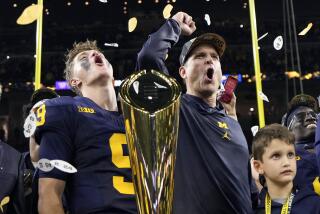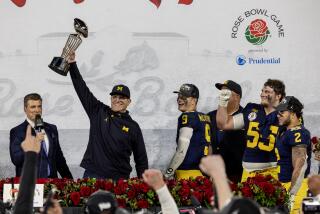Bye-bye BCS: College football will have a four-team playoff
They said it wasn’t a rubber stamp decision, but it ended with high fives.
After years of debate, and ultimately compromise, a playoff in college football is at long last coming.
The Bowl Championship Series, born in 1998, soon will be dead.
If you’re near one, hug a mascot.
The final hurdle was cleared Tuesday in Washington, where university presidents heard, discussed and then approved conference commissioners’ plans for a four-team playoff starting in 2014.
The new format will be a 12-year deal, through 2025, basically to keep at bay proponents of a larger, basketball-type format. Football commissioners call this unwanted path “bracket creep.”
A selection committee will be used to determine the top four teams. Six bowls, including the Rose, Sugar, Fiesta and Orange, will be used to rotate annually the two national semifinal games. The other two bowls have not yet been determined, nor has the rotation cycle.
The Rose Bowl, in years when it is not a semifinal, will host its traditional Pac-12 vs. Big Ten matchup.
The national title game will be awarded to the highest, neutral-site bidder. It will become more like a Super Bowl event.
If all this sounds familiar, it’s because the basic blueprint has been reported on for weeks. Final details still need to be worked out, but the fundamentals are in place.
The four-team format will satisfy those who have long clamored for a playoff in college football, yet will fall short for those who favored an eight- or 16-team model.
“A four-team playoff doesn’t go too far,” Virginia Tech President Charles W. Steger, chair of the BCS Presidential Oversight Committee, said at a post-meeting news conference. “It goes just the right amount. We are pleased with the arrangement, even though some issues remain to be finalized.”
Big Ten Commissioner Jim Delany said the limited playoff will help protect college football’s successful regular season.
“It’s a balance between what we have and know,” he said of the new format.
The BCS expires after the Rose Bowl hosts the title game in January of 2014.
Tuesday’s biggest surprise was the speed with which the presidents came to a consensus. There was speculation debate could drag into next fall.
“I thought we worked rather efficiently today,” Steger said.
Nebraska Chancellor Harvey Perlman, the most outspoken critic of the new plan, ultimately conceded to the consensus. Perlman, a member of the BCS committee, said the Big Ten preferred status quo or the “plus one” model, a title game played after the bowls.
“We got our third priority,” Perlman said, adding that the Big Ten would “strongly support” the new model.
It has been a slow, arduous grind toward change. BCS Commissioners, at their April meetings in Florida, emerged with a plan to present a limited number of four-team options to their conference representatives.
That plan originally met resistance from the Pac-12 and Big Ten, who have a vested interest in protecting their annual Rose Bowl matchup. However, the commissioners emerged from last week’s meeting in Chicago unified on the four-team model.
The BCS exits the stage as a villain to most but was actually formed in 1998 as an attempt to bring some clarity to a sport that had resisted any sort of playoff since Rutgers and Princeton first squared off in 1869.
Major college football national titles had long been mythical entities granted by various polls and wire services. Long-standing contractual agreements with bowls complicated playoff possibilities and made it difficult to pair the top two teams in an annual “championship” game.
The champions of the Big Ten and Pac-12, since 1947, have had an agreement to play each other in the Rose Bowl.
The BCS was possible only because the Rose Bowl agreed to release its champions to a title game in years when those teams were ranked No. 1 or No. 2.
A complicated matrix of computers and polls, called the BCS standings, was used to determined the top teams.
It worked some years and in others failed miserably. In 2003, for example, USC finished third in the BCS standings despite being No. 1 in the coaches’ and writers’ polls. That led to a split title between Louisiana State and USC, the very thing the BCS was designed to prevent.
In 2004, a holy war nearly broke out between Texas and California for the coveted No. 4 spot in the standings. Major controversy erupted when Texas edged Cal for the spot, denying the Golden Bears their first Rose Bowl trip since 1959.
Protecting the tradition of the Rose Bowl in any new format was a priority for the Pac-12 and Big Ten.
“There has been a lot of give and take,” Pac-12 Commissioner Larry Scott said in advance of Tuesday’s meetings. “ At the end of the day, what is good for college football is good for the Rose Bowl, and vice-versa.”
Scott was assured the selection committee would emphasize conference finish and strength of schedule in their decision-making. Win-loss record and head-to-head results will also be determining factors.
Tuesday wasn’t Christmas for most college football fans because it will be two more years before anyone can open a present.
But, for many, it was close.
More to Read
Go beyond the scoreboard
Get the latest on L.A.'s teams in the daily Sports Report newsletter.
You may occasionally receive promotional content from the Los Angeles Times.











